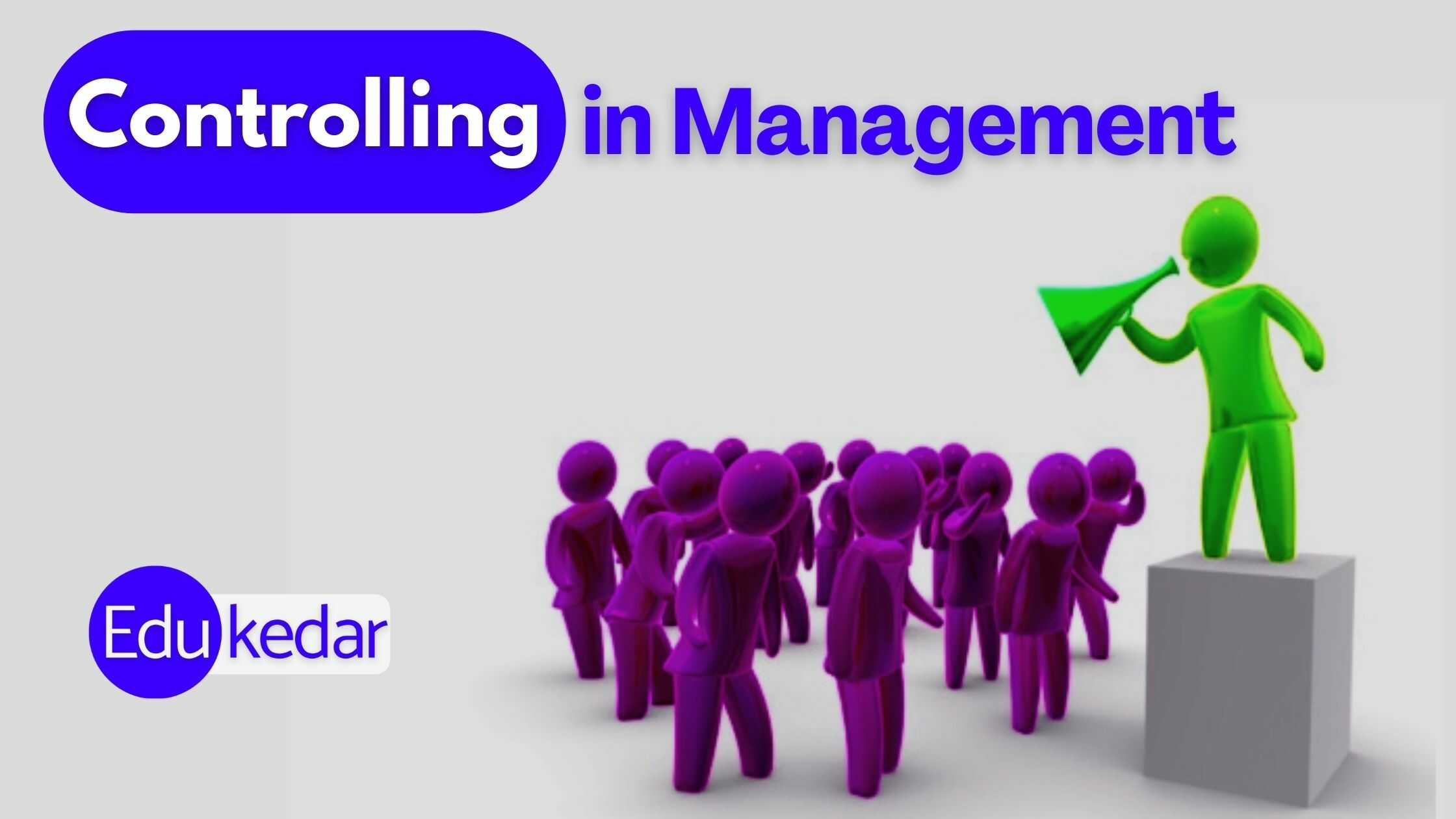Controlling in management is a cyclic process that involves comparing actual performance with the set standard of the company, to guarantee the effective accomplishment of organizational objectives.
Controlling is the last function of management in which activities such as Setting standards, ensuring implementation, genuine execution, and taking corrective actions in the event of deviations are all important for the managerial job of controlling function in management.
Here in this article, we have shared definitions of controlling, steps involved in the controlling process, features and characteristics of control, and the importance of controlling in management.
► What is Controlling in Management?

Controlling is one of the most basic functions of management such as planning, organizing, staffing, etc. Controlling is very essential in the management process because without controlling management can’t ensure the desired results.
Definition of Controlling in management
Controlling can be defined as a function of ensuring the actions of the employees and workers of an organization are directed towards the attainment of a common goal and objectives and the work is being performed as planned by the management.
“Controlling is the act of monitoring and correcting all activities in an organization to ensure they are being accomplished as planned.”
Definition of Controlling by renowned Authors
Controlling is the process of checking whether or not expected progress is being made towards the objectives and goals and acting if necessary, to correct any deviation.
– Theo Haimann
Controlling is the measurement & correction of performance activities of subordinates in order to make sure that the organizational objectives and plans desired to obtain them as being accomplished. – Koontz & O‟Donell
Meaning of Controlling in management
Controlling means guaranteeing that exercises in an organization are proceeded according to the plans. Controlling likewise guarantees that an organization’s assets are being utilized viably and effectively for the achievement of wanted objectives.
Must Read :What is Management?
► Objectives or Benefits of Controlling
Objectives or Advantages and Benefits of Controlling in management are as follows;
- Identify the actual progress of the work in the company.
- It helps the R&D department to improve efficiency.
- It facilitates coordination in the organization.
- To measure the actual performance with the set standard.
- To calculate the actual quantity and quality of the product.
- To eliminate wastage of resources.
- To meet the deadline of the projects.
► Importance of Controlling in Management
- Controlling aides in accomplishing authoritative objectives
- Passing judgment on the exactness of guidelines
- Making efficient use of resources
- Improving employees’ motivation
- Ensuring order and discipline
- Facilitating Coordination in action
◉ Controlling aides in accomplishing authoritative objectives:
The controlling capacity tracks progress toward hierarchical destinations and banners any deviations so healing moves can be made.
◉ Passing judgment on the exactness of guidelines:
A successful control framework permits the executives to decide whether the principles set are precise or not by intently checking changes in the association’s current circumstances.
◉ Making efficient use of resources:
A director can lessen asset squandering by successfully using assets through the controlling system.
◉ Improving employees’ motivation:
A powerful control framework ensures that staff knows about how they are relied upon to treat well as the exhibition necessities. Thus, it rouses and helps them in conveying prevalent outcomes.
◉ Ensuring order and discipline:
By keeping a cautious eye on the exercises of its representatives, the controlling capacity creates an environment of request and discipline in the firm.
◉ Facilitating Coordination in action:
The last and most pivotal job of controlling is to guarantee that every office and representative is administered by foreordained norms and objectives that are surely known and facilitated. This ensures that the association’s general objectives are met in an ideal manner.
► Characteristics/Nature/Features Of Controlling
- Goal-Oriented
- Pervasive
- Continuous
- Controlling is the process of reviewing staff performance
- It is a forward-looking function
- It is subject to the preparation
- Action-oriented
◉ Goal-Oriented (controlling in management)
The fulfillment of characterized objectives or goals decides the accomplishment of any administration exertion.
◉ Pervasive (controlling in management)
Controlling is needed in a wide range of associations whether it is benefit making, non-benefit making, business or non-business, at all levels whether it is high-level administration or center-level administration, or lower-level administration.
◉ Continuous (controlling in management)
Continuous performance advancement is a constant, forward-looking way to deal with execution that organizations use to adjust and develop their kin while helping them in their prosperity.
◉ Controlling is the process of reviewing staff performance
By controlling capacity, the administration can keep a beware of the presentation, devotion, and trouble spots of the staff.
◉ It is a forward-looking function
Controlling is a forward-looking capacity, as it helps in concluding the future strategy in the event that the genuine exhibition doesn’t coordinate with the principles set.
◉ It is subject to the preparation
Controlling is reliant upon the arranging capacity, as the examination of real execution is made with the arranged exhibition. Consequently arranging goes about as a base for controlling.
◉ Action-oriented (controlling in management)
The focal point of the board is on achieving the work with the assistance of HR. It is the viable and productive coordination of every accessible asset. The activities in an association are completed by subordinates, or laborers, who work under the oversight of a supervisor.
► Limitations Of Controlling
Here are the disadvantages or limitations of controlling in management.
- Difficulty in setting quantitative standards
- Little control over external factors
- Resistance from employees
- Costly affair
◉ Difficulty in setting quantitative standards
When guidelines can’t be estimated, a control framework loses a portion of its viability.
◉ Little control on external factors
External components like government regulation, specialized headways, and rivalry, among others, are past the control of an organization.
◉ Resistance from employees
Employees, generally, detest being constrained by their supervisors and they detest being in steady cautiousness of the administration.
◉ Costly affair (controlling in management)
Control is a costly method since it requires a truckload of cash, time, and exertion as far as setting principles, estimating execution, and revising the deviations.
► Process of Controlling in Management
In an organization, the controlling process is an important function for the managers. It is an act of comparing actual performance with the organization’s guidelines to guarantee that activities are completed by the plans.
And in case, if there is a deviation in actual performance and the set standards then corrective action is taken by the management.
The steps involved in process of Controlling are as follows;
- Step 1: Setting Performance Standards
- Step 2: Measurement Of Actual Performance
- Step 3: Comparing Actual Performance with standards
- Step 4: Analyzing Deviation
- Step 5: Taking Corrective Action
Must Read :What is Planning in Management?
► Relationship between Planning and Controlling
Planning and controlling are intertwined and commonly supported as in:
- Planning is needed for powerful control. The standard for controlling is set by plans. Administrators have no impact on anything in the event that the norms aren’t characterized early.
- Without control, planning is useless. At the point when control is worked out, it is productive. It recognizes any deviations and makes a restorative move is vital.
- Controlling surveys the proficiency of arranging and helps in the execution of healing activities.
- Planning is forward-thinking, though controlling is in reverse reasoning. Arranging is a future-situated action since it involves thinking ahead and setting up strategies to boost asset use later on, which is the reason it is alluded to as a forward-looking capacity.
- In control, we look at the representatives’ past presentations and contrast them with the setup prerequisites. Assuming there are any disparities between genuine and expected execution or result, the controlling capacities guarantee that future real exhibition meets anticipated execution. Thus, controlling is a capacity that looks forward.
- Accordingly, arranging and controlling are interlaced, and they walk connected at the hip. Controlling climbs to a higher level on account of arranging, while arranging upgrades for future controlling.
Also Read :Steps in Planning Process
Techniques of controlling
Managerial control or techniques of controlling in management is divided into two classes.
- Traditional techniques of controlling
- Modern techniques of controlling
1. Traditional Techniques of controlling
- Personal observation
- Budgetary control
- Break-even analysis
- Costing
- Special reports analysis
- Statistical data
2. Modern Techniques of controlling
- Return on investment (ROI)
- Responsibility account
- Human resource account
- Performance budgeting
- Program evaluation and review technique (PERT)
- Critical path method
- Management info system (MIS)
- Zero-based budgeting
- Six Sigma
- Total Quality Management (TQM)
- Social audit
- Management audit
Also Read :Human Resource Planning (HRP)





